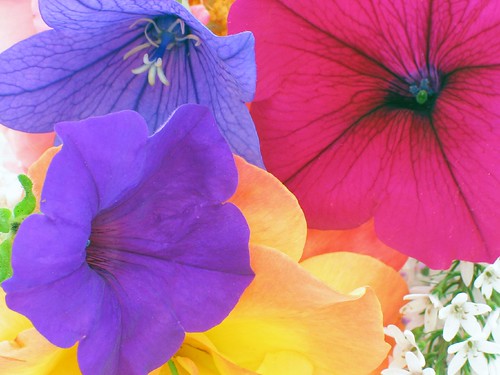The smaller the aperture (opening in the lens), the greater the depth of field (the distance in front and behind a subject that is apparently in focus). The aperture designated by the very small f-stop f/64 provides much greater depth of field than the far larger aperture of f/1.4. Small apertures with great depth of field are used to create photos that are entirely in focus; large apertures with low depth of field are used to isolate in-focus elements in a photo from the photo’s background.
Depth of Field and Aperture shows a high depth of field (using a small aperture opening at f/32) version and a low depth of field (a big aperture opening at f/4) photo of the same flower. If you look at the two photos in that story, it’s easy to see the impact of aperture on depth of field (and the visual implications of high or low depth of field).
Both Dahlia photos in the depth of field demonstration were taken with my Nikon D200. It may seem odd, but the macro photo below, taken with an old Canon Powershot G3 at f/8, shows about as high depth of field than the D200 photo of the Dahlia taken with a macro lens at f/32. What gives?
It’s well known that telephoto lenses have less depth of field than wide angle lenses. In other words, the wider the angle of view, the greater the depth of field. It’s perhaps less understood that the size of the sensor has a direct impact on depth of field. The smaller the sensor size, the greater the depth of field at a given effective focal length and f-stop.
Sensors are classified by their crop factor, which compares the sensor with a frame of 35mm film. My D200 (and all the Nikon dSLRs) have a sensor crop factor of 1.5, meaning that comparing width-to-width, the D200 sensor is smaller in a ratio of 1/1.5 compared to a 35mm frame. The Canon G3 used to take the photo above, like all fixed lens digital cameras, has a much smaller sensor, about 4.5 crop factor, meaning that the ratio to the 35mm film is 1/4.5, and the G3 sensor is about 1/3 the size of the Nikon sensor. (Worth noting: Canon dSLRs, as opposed to the fixed-lens Canon used here, have comparatively large sensors, many of them actually 1:1 with 35mm.)
The effective focal length of 140mm on the Canon isn’t that different in terms of depth of field from the 157.5mm used on the Nikon photo of the Dahlia (both are moderate telephotos). So the only real variables regarding depth of field between the photos is sensor size and aperture. Depth of field is directly proportionate to sensor size. So the Canon has 4.5:1.5 the depth of field (or three times the depth of field) as the Nikon at any given aperture. The f/8 aperture on the Canon gives as much depth of field as somewhere between f/11 and f/16 would on the Nikon.
Advantages and disadvantages? More depth of field at moderate apertures on the small sensor fixed-lens digital cameras means that you can take images with everything in focus (particularly in macro mode) without having to go to excruciatingly long exposures. (However, note that many of these cameras will only allow you to use macro mode at the maximum telephoto end of their zoom ranges.) Photos of general subjects taken with a camera that has a small sensor will exhibit high depth of field, often a good thing. However, even at the biggest aperture settings you still have plenty of depth of field with small sensor cameras. This means that it’s hard to take photos that isolate subjects, like flowers against a blurred background, or portraits where the background is out of focus.
It’s also a fact of life that the smaller the sensor, the smaller the pixel. Smaller pixels mean more noise. Therefore, for a given size capture, small sensor images will always have inherently more noise than larger sensor images.

Pingback: Photoblog 2.0: » Photoblog 2.0 Archive: » Nonpareil